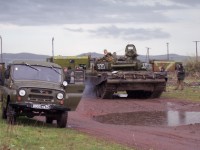
GEORGIAN FLAG RAISED OVER AKHALKALAKI
Publication: Eurasia Daily Monitor Volume: 4 Issue: 128
By:

The flag of Georgia has been flying over the Akhalkalaki military base since June 27, with Georgian troops moving onto the base to replace the last Russian troops. The commander of the Group of Russian Forces in the Transcaucasus (GRVZ), Maj.-General Andrei Popov, and Georgia’s First Deputy Defense Minister, Maj.-General Levan Nikolaishvili, signed the handover documents on that day, as Russian troops completed the evacuation of materiel from the sprawling base.
Fixed assets handed over to the Georgians include 196 buildings on an area of 128 hectares as well as a nearby combat training range. The last 150 Russian troops left on the eve of the official handover. The evacuation of materiel and troops began in late 2004 on an ad-hoc basis and continued from mid-2006 onward in accordance with an agreed timetable. The Russians have completed it three months ahead of the October 2007 deadline.
While some of the materiel and troops have been evacuated to Russia, a considerable quantity of hardware has been transferred to the Russian base at Gyumri in Armenia — a move that raises concern in Azerbaijan. The Russian arsenals at Gyumri are steadily growing through transfers of heavy weaponry from Russian bases in Georgia. The Georgian-Russian agreements prohibit the transfer of that weaponry to Armenian forces by Russia. However, compliance with the ban and indeed the actual basing location of that hardware, once it reaches Armenia, is difficult to verify.
The Imperial Russian Army built the Akhalkalaki base in 1910 from an earlier military outpost near the Ottoman border. The base was expanded to accommodate up to 15,000 Soviet troops during the Cold War. Its missions included launching offensive operations into Turkey in the event of actual war.
After the Soviet Union’s collapse, the Akhalkalaki base became the main employer and for the local ethnic Armenian-majority population and main buyer of goods and services. Russian authorities in Moscow and in the theater instigated local Armenians at times to demonstrate against the closure of the base and even to block the evacuation path of military convoys. However, such incidents stopped in 2006 when Russia began implementing its agreement with Georgia on the withdrawal of Russian forces.
The evacuation process continues from Russia’s base at Batumi, where 800 Russian soldiers remain. Under the withdrawal schedule, the ninth railroad train left Batumi on June 28 for Russia and the tenth is scheduled to leave at the beginning of July for the Russian base at Gyumri in Armenia. The materiel aboard these trains includes tanks, various types of armored vehicles, and artillery systems as well as infantry equipment. Ten more trains and one more motor convoy are to be sent from Batumi until the end of 2007. The base is due to close before the end of 2008.
From 1991 through 2005, Russia stonewalled the negotiations on troop withdrawal, attempting to prolong its presence at Akhalkalaki and Batumi indefinitely. Even after the signing of the 1999 Istanbul agreements on troop withdrawal, Russia wanted at least another decade to close these two bases and demanded hundreds of millions of dollars as compensation for relocating the troops and materiel in Russia. The only Istanbul commitment that Russia fulfilled on time was the handover of the Vaziani base and airport near Tbilisi in 2001.
The 2003 regime change in Georgia and the reestablishment of effective Georgian sovereignty in Ajaria changed the negotiations fundamentally. Moscow understood that the location of Akhalkalaki and Batumi, deep inside Georgian territory, meant that the bases could be isolated and even blockaded if Russia refused to honor its obligation to close them down. This realization — as well as the loss of real military value of these bases — led Moscow to agree to evacuate them. The withdrawal process is governed by the May 30, 2005, Joint Statement and March 31, 2006, implementing agreements, which were signed, respectively, by Russia’s Minister of Foreign Affairs Sergei Lavrov and Ground Forces Commander-in-Chief Colonel-General Alexei Maslov, with Georgia’s then-minister of foreign affairs Salome Zourabichvili and then-first deputy defense minister Mamuka Kudava. These documents stipulate a precise timetable for withdrawal, with interim deadlines to be met (see EDM, June 3, 2005; April 4, 2006).
On Christmas Day, December 25, 2006, the last personnel of Russia’s garrison in Tbilisi and the rump GRVZ Headquarters pulled out of Georgia’s capital and of the country altogether. That move brought to a close more than 200 years of the Russian garrisoning of Tbilisi. The imperial Russian army under General Ivan Lazarev occupied Tbilisi in November 1799, using the easy invasion route from Ossetia. The sprawling ex-GRVZ complex is located on prime real estate grounds in downtown Tbilisi, in proximity to the main government institutions (see EDM, January 2).
As part of its 1999 commitments, enshrined in the CFE Treaty’s Final Act at that year’s Istanbul summit, Russia was to close the Gudauta base, evacuate the personnel and equipment, and hand the base over to Georgia by July 1, 2001. However, Russia retains the base to the present day, albeit with a reduced garrison (see EDM, June 18). While giving Russia due credit for evacuating the Batumi and Akhalkalaki bases and the Tbilisi headquarters — even ahead of the 2005-stipulated deadlines — Georgia calls for complete fulfillment of the CFE Treaty and Istanbul Commitments regarding the Gudauta base.
(Civil Georgia, Messenger, Interfax, June 27-30)




